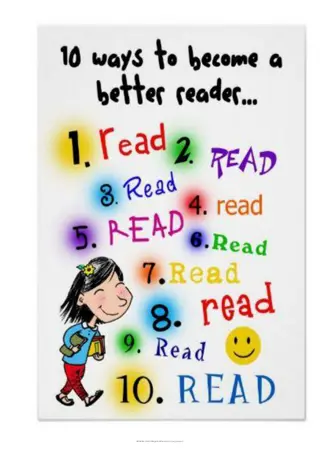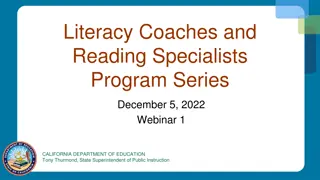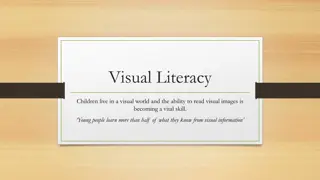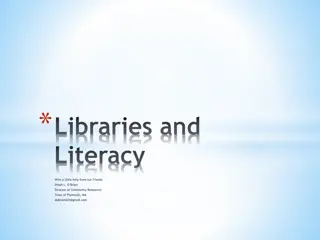Importance of Foundational Literacy Skills in Early Reading Development
Early literacy skills play a crucial role in predicting academic success and reducing reading problems. Regardless of the reasons for reading struggles, foundational skills must be mastered early on. While various instructional methods exist, focusing on explicit, systematic, and intense approaches can be most beneficial for students' reading development.
Download Presentation

Please find below an Image/Link to download the presentation.
The content on the website is provided AS IS for your information and personal use only. It may not be sold, licensed, or shared on other websites without obtaining consent from the author. Download presentation by click this link. If you encounter any issues during the download, it is possible that the publisher has removed the file from their server.
E N D
Presentation Transcript
HomeButton.png The Foundation of Literacy: Explicit, Systematic, and Intense TIMOTHY SHANAHAN UNIVERSITY OF ILLINOIS AT CHICAGO WWW.SHANAHANONLITERACY.COM
HomeButton.png Importance of Early Literacy Early reading problems tend to persist and lead to other academic problems (Barr & Parret, 1995; Cunningham & Stanovich, 1999; Fletcher & Satz, 1982; Entwistle & Hadyuk, 1988; Jacobson, 1999; Juel, 1988; Shaywitz, et al., 1999) Early reading performance is predictive of life success (Ritchie & Bates, 2013) Studies show that it is possible to dramatically reduce the incidence of early reading problems (Allington, 2014; Fletcher & Lyon, 1998; Torgesen, 2006)
HomeButton.png Nature of Struggling Readers There are many reasons why students may struggle in reading (e.g., poverty, second language learners, disabilities, individual differences) However, while etiology may differ, what students need to learn to become successful readers is going to be the same (how much attention needs to be accorded to the various essential components may vary)
HomeButton.png More than Foundational Skills This morning my focus will be on Foundational Skills, that is those basic skills that need to be mastered relatively early in the reading process (skills that are foundational to more complex and more sophisticated processes that develop later) These foundational skills are not the only reading skills that matter, or even the only skills that require attention in the primary grades (Stuebing, Barth, Cirino, Francis, & Fletcher, 2008) I won t be talking directly about reading comprehension or learning from text or composition though ultimately the entire point of teaching foundational skills is to provide advantages in these valued outcomes
HomeButton.png Many Routes to Reading Stipulation: There are many different methods and instructional practices for teaching reading including some that don t provide the kind of instruction that I ll describe this morning--and they all seem to work to some extent However, while all methods seem to teach some kids to read, there is variability across approaches with regard to how efficient they are, how well students come to read, how many kids learn to read, or how long-lasting their advantages are Need to focus on the most powerful approaches given the needs of our students
HomeButton.png Nature of Research Evidence Value of research evidence is two-fold: allows for improvements that would not occur without research and allows for rational governance Research evidence varies in the nature of the claims that it allows, quality/relevance of the work, and amount of research evidence available There are systematic ways of evaluating and synthesizing research evidence Magnitude of effect matters
HomeButton.png Research on Foundational Skills National Reading Panel (2000) National Early Literacy Panel (2008) National Literacy Panel for Language Minority Children and Youth (2006) Individual studies completed since those reports
HomeButton.png Components of Literacy Letters Oral reading fluency Phonological awareness Vocabulary/Language Phonics Reading comprehension High frequency words Writing/Spelling
HomeButton.png Foundational Skills and Knowledge Letters Oral reading fluency Phonological awareness Phonics High frequency words Spelling
HomeButton.png Beginning Reading Alphabetic writing system: This means that a set of letters is used to transcribe the sounds of phonemes in a language (rather than attempting to transcribe the meaning directly) To read an alphabetic script it is necessary to go from script to sound to meaning Knowing how to use the letters to cue access to meaning is essential in reading
HomeButton.png Logographic System
HomeButton.png What do you need to read in an alphabetic system? Knowledge of the written symbols the alphabet (names, sounds, recognition) Ability to hear phonemes Ability to match phonemes to letters or patterns accurately and fluently enough to approximate words in oral language Enough knowledge of language/meaning to be able to self-evaluate effectiveness
HomeButton.png Letters Letter name knowledge is one of best predictors of later reading achievement (Adams, 1990; Hammill, 2004; Scarborough, 1998; Schatschneider, et al., 2004; National Early Literacy Panel, 2008) Letter name knowledge is an important indicator of later reading disability (Gallagher, et al., 2000; O Connor & Jenkins, 1999; Torppa, et al., 2006) Alphabet knowledge remains significant even when controlling for age, SES, oral language, phonological awareness, or IQ (NELP, 2008)
HomeButton.png Letters (cont.) There are studies of the teaching of alphabet knowledge, but none of these studies have reading outcomes However, studies suggest that letter name teaching in combination with phonological awareness or decoding is beneficial to reading achievement and phonological awareness development more rapid when letter names known (Kim et al, 2010) Studies show best letter name learning occurs when the instruction is combined with letter sounds (Piasta & Wagner, 2010) and that it is important to separate similar letters (visual and aural)
HomeButton.png Indiana Standards Print Concepts K.RF.2.1 Demonstrate understanding that print moves from left to right across the page and from top to bottom. K.RF.2.2 Recognize that written words are made up of sequences of letters. K.RF.2.3 Recognize that words are combined to form sentences K.RF.2.4 Identify and name all uppercase (capital) and lowercase letters of the alphabet
HomeButton.png Phonological Awareness PA is the ability to detect, manipulate, or analyze the auditory aspects of spoken language independent of meaning Phonemic Awareness refers to the ability to hear and manipulate the sounds within words (it is a part of Phonological Awareness) Development of PA progresses from distinguishing gross sounds (words, syllables) to finer-grained sounds (phonemes) The instructional goal is to enable children to be able to easily and quickly fully segment the phonemes within words
HomeButton.png Phonological Awareness (cont.) National Early Literacy Panel (2008) reviewed nearly 68 studies showing that phonological awareness was a strong predictor of later reading achievement PA remains a significant predictor even controlling for age, SES, alphabet knowledge, oral language, IQ, or prior decoding ability NELP meta-analyzed approximately 50 studies finding that instruction in PA in pre-K and/or K (alone, combined with AK, combined with phonics) led to significant impacts on PA, AK, Reading, Spelling
HomeButton.png Phonological Awareness (cont.) NRP meta-analyzed more than 51 studies finding that phonemic awareness instruction in K, 1, and remediation led to significant improvements in phonemic awareness, decoding, reading comprehension, and spelling (NICHD, 2000) NLP (2008) found that phonemic awareness instruction was beneficial for second-language students More recent studies show that the benefits of such teaching persist for a longtime (Roberts & Meiring, 2006)
HomeButton.png Phonological Awareness Skills Skills Word separation Phoneme blending Syllable segmentation Phoneme segmentation Onset/rime Phoneme addition Phoneme identity Phoneme substitution Phoneme isolation Phoneme deletion
HomeButton.png Instruction of PA Has to be done orally; students have to hear the sounds (not with text clues) Brief intensive instruction Instruction should emphasize 1-2 skills at a time Progression is from grosser sounds to smaller sounds (words- syllables-phonemes) Should be combined with alphabet instruction
HomeButton.png Indiana Standards - K Phonological Awareness K.RF.3.1 Identify and produce rhyming words. K.RF.3.2 Orally pronounce, blend, and segment words into syllables K.RF.3.3 Orally blend the onset (the initial sound) and the rime (the vowel and ending sound) in words. K.RF.3.4 Tell the order of sounds heard in words with two or three phonemes, and identify the beginning, middle (medial) and final sounds. K.RF.3.5 Add, delete, or substitute sounds to change words.
HomeButton.png Indiana Standards - 1 Phonological Awareness 1.RF.3.1 Students are expected to build upon and continue applying concepts learned previously. 1.RF.3.2 Blend sounds, including consonant blends, to produce single- and multi- syllable words. 1.RF.3.3 Add, delete, or substitute sounds to change single-syllable words. 1.RF.3.4 Distinguish beginning, middle (medial), and final sounds in single- syllable words. 1.RF.3.5 Segment the individual sounds in one-syllable words.
HomeButton.png Phonics Phonics refers to instruction aimed at teaching the alphabetic system of English; includes sound-symbol correspondences and the relationships between spelling patterns and pronunciations of words. Decoding from print to pronunciation. But does phonics instruction help given the inconsistencies of English spelling patterns?
HomeButton.png ghoti
HomeButton.png ghoti Enough Women Nation
HomeButton.png English spelling highly consistent Examination of most frequent 20,000 words in English reveals high percentage of consistency (Venezky, 1970) But consistency depends not just on sound-symbol relationships but on the position of the letters in words and on morphology Ghoti couldn t happen in English, and there are benefits to phonetic/orthographic inconsistencies like cat/s/ and dog/z/
HomeButton.png Phonics However, there are far more rules, patterns, consistencies than we could possibly teach (Apfelbaum, Hazeltine, & McMurray, 2013) There has long been controversy over phonics: the controversy is not whether students need to decode or not, just whether such instruction is helpful/necessary (Barr, 1972; Biemiller, 1970) Theory: Explicit teaching of phonics does not teach reading per se, but provides readers with a handle on some of the most useful consistencies and sets them off to pay attention to other patterns that might help
HomeButton.png Phonics (cont.) NELP examined 70 studies on decoding instruction (includes those PA studies noted earlier); found that such instruction in preschool and kindergarten had moderate to large impacts on students reading and spelling development and on various emergent literacy skills NRP examined 38 studies on phonics instruction and found that such teaching in grades K-2 and with older remedial readers had a positive impact on decoding and fluency and on reading comprehension and spelling as well K-2.
HomeButton.png Phonics (cont.) NLP found explicit decoding instruction to be beneficial to English learners as well (though there are only a few studies with this population and the effect sizes were smaller than for native English speakers) Studies continue to accumulate supporting these same conclusions (e.g.,Cihon, Gardner, Morrison, & Paul, 2008; Ehri, Dreyer, Flugman, & Gross, 2007; Savage, Abrami, Hipps, & Deault, 2009; Vadasy & Sanders, 2012a, 2012b)
HomeButton.png Phonics (cont.) Effective phonics instruction is explicit and systematic Multiple years of phonics instruction were better than single years Virtually all programs of phonics work with young children (NRP, WWC) however, thoroughness matters No single phonics sequence did better than any other Spelling
HomeButton.png Phonics (cont.) Phonics instruction should include lots of opportunity for students to decode and encode words Important to develop a mental set for diversity (Apfelbaum, Hazeltine, & McMurray, 2013) Important that texts are consistent with the decoding skills being taught (Guthrie & Seifert, 1976; Venezky & Johnson, 1973)
HomeButton.png High frequency words Words differ in their frequency in the language (some words are used a lot and others appear rarely) In English, the 300 most frequent words in the language (and their derivations) make up about 75% of all the words one sees in texts it can be useful to know these words especially well Also, the origins of our language are complex: the alphabetic properties of English are complex this is particularly true of some of the most common words in the language (e.g., the, of, where); can be easier to memorize these rather than decoding them
HomeButton.png High frequency words (cont.) Sight vocabulary refers to words that someone can read as if they were not decoding appears like they are effortlessly pulling them back from memory and recognizing them as a whole Given the value of high frequency words it would make sense that students learn these as sight words However, the story is more complex than that student memory for words is highly dependent upon decoding (phonics makes words stickier ); sight vocabulary is to a great degree an outcome of decoding (Ehri, 2005)
HomeButton.png High frequency words (cont.) Teaching sight vocabulary can improve fluency and comprehension (Griffin & Murtagh, 2015) Teach words by focusing attention on the order of letters (not mnemonics, pictures, etc.) and work with them both in isolation interval training and in context (Browder & Lalli, 1991; Fossett & Mirenda, 2006) Visualization is essential
HomeButton.png High frequency words (cont.) Texts used in K-1 should include decodable text along with high frequency words Direct work on memorizing words should be minimal (lots of programs are overdoing this now) My goal: 100 most frequent words by end of Grade 1, and 300 most frequent by end of Grade 2
HomeButton.png Indiana Standards Phonics K.RF.4.1 Use letter-sound knowledge to decode the sound of each consonant (e.g., dog = /d/ /g/; soap = /s/ /p/). K.RF.4.2 Blend consonant-vowel-consonant (CVC) sounds to make words. K.RF.4.3 Recognize the long and short sounds for the five major vowels. K.RF.4.4 Read common high-frequency words by sight (e.g., a, my). K.RF.4.5 Identify similarities and differences in words (e.g., word endings, onset and rime) when spoken or written.
HomeButton.png Indiana Standards Phonics 1.RF.4.1 Use letter-sound knowledge of single consonants (hard and soft sounds), short and long vowels, consonant blends and digraphs, vowel teams (e.g., ai) and digraphs, and r-controlled vowels to decode phonetically regular words (e.g., cat, go, black, boat, her), independent of context. 1.RF.4.2 Decode one-syllable words in the major syllable patterns (CVC, CVr, V, VV, VCe), independent of context. 1.RF.4.3 Apply knowledge of final e and common vowel teams (vowel digraphs) for representing long vowel sounds. 1.RF.4.4 Recognize and read common and irregularly spelled high-frequency words by sight (e.g., have, said). 1.RF.4.5 Read words in common word families (e.g., -at, -ate). 1.RF.4.6 Read grade-appropriate root words and affixes including plurals, verb tense, comparatives (e.g., look, -ed, -ing, -s, -er, -est), and simple compound words (e.g., cupcake) and contractions (e.g., isn t).
HomeButton.png Indiana Standards Phonics 2.RF.4.2: Use knowledge of the six major syllable patterns (CVC, CVr, V, VV, VCe, Cle) to decode twosyllable words, independent of context 2.RF.4.3: Apply knowledge of short and long vowels (including vowel teams) when reading regularly spelled one-syllable words. 2.RF.4.4: Recognize and read common and irregularly spelled highfrequency words and abbreviations by sight (e.g., through, tough; Jan., Fri.). 2.RF.4.5: Know and use common word families when reading unfamiliar words (e.g., - ale, -est, -ine, -ock). 2.RF.4.6: Read multisyllabic words composed of roots, prefixes, and suffixes; read contractions, possessives (e.g., kitten s, sisters ), and compound words.
HomeButton.png Indiana Standards Phonics 3.RF.4.2: Understand the six major syllable patterns (CVC, CVr, V, VV, VCe, Cle) to aid in decoding unknown words. 3.RF.4.4: Read gradeappropriate words that have blends (e.g., walk, play) and common spelling patterns (e.g., qu-; doubling the consonant and adding ing, such as cut/cutting; changing the ending of a word from y to ies to make a plural).
HomeButton.png Oral Reading Fluency Oral reading fluency refers to the ability to read text aloud with accuracy, speed, and proper expression. It is not a pure skill but an amalgamation of skills (e.g., decoding, comprehension) Developmental pattern: initially accuracy is especially important, but as students proceed through the grades speed, and eventually. prosody become more important (e.g., higher correlations with reading comprehension)
HomeButton.png Oral Reading Fluency (cont.) In second grade, fluency explains about 85% of the variation in reading comprehension (this declines over time, but is still important in Grade 8) NRP reviewed 16 experimental studies showing that fluency could be taught explicitly and that such instruction had a positive impact on decoding, word recognition, fluency, and reading comprehension (with students in grades 1-4, and with struggling readers in grades 1- 12)
HomeButton.png Indiana Standards K.RF.5: Read emergent reader texts, maintaining an appropriate pace and using self-correcting strategies while reading. 1.RF.5: Orally read grade-level appropriate or higher texts smoothly and accurately, with expression that connotes comprehension at the independent level. 2.RF.5: Orally read grade-level appropriate or higher texts smoothly and accurately, with expression that connotes comprehension at the independent level. 3.RF.5: Orally read grade-level appropriate or higher texts smoothly and accurately, with expression that connotes comprehension at the independent level.
HomeButton.png Explicitness Explicit teaching is intentional Explicit teaching makes sure that students have a clear idea of what is being taught, why it is being taught, and how to use it Explicit (or direct) teaching includes telling or explanation, but it also may include modeling, guided practice, and independent practice Because the teaching is explicit it is possible to monitor success and to provide reteaching
HomeButton.png Oral Reading Fluency (cont.) Research has continued to accumulate supporting the teaching of oral reading fluency in the primary grades and to struggling readers through secondary school (Chard, Vaughn, & Tyler, 2002; Marr, Algozzine, Nicholson, & Dugan, 2011; O Connor, White, & Swanson, 2007; Schwanenflugel, Kuhn, Morris, Morrow, et al., 2009) Basically, the studies reveal that oral reading practice with feedback and repetition with frustration level texts improves fluency (modeling can help, too)
HomeButton.png Systematic Systematic teaching refers to the importance of having a clear and consistent sequence of instruction A systematic program will present a planned sequence of skills which ensures coverage of essential knowledge and sufficient thoroughness of coverage
HomeButton.png Intensity Sufficient amounts of time Pooled practice Opportunities for reteaching Opportunities for review Teaching students not just the patterns, but how to use the patterns (e.g., blending practice) Overteaching (spelling not just reading)
HomeButton.png Summary Students do best in reading when they receive substantial amounts of teaching and practice in phonological awareness, phonics, sight vocabulary, oral reading fluency This instruction needs to be explicit, systematic, and intense And it needs to be provided in the context of explicit instruction and practice in other essential aspects of literacy (e.g., vocabulary/language, reading comprehension, writing)























